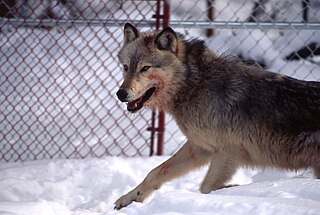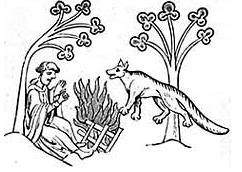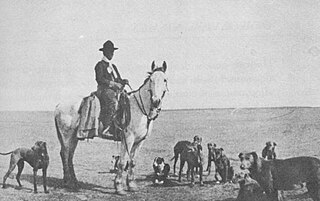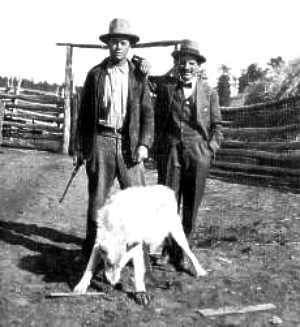
The coyote, also known as the American jackal, prairie wolf, or brush wolf, is a species of canine native to North America. It is smaller than its close relative, the gray wolf, and slightly smaller than the closely related eastern wolf and red wolf. It fills much of the same ecological niche as the golden jackal does in Eurasia; however, the coyote is generally larger.

The wolf, also known as the gray wolf or grey wolf, is a canine native to Eurasia and North America. More than thirty subspecies of Canis lupus have been recognized, including the dog and dingo, though gray wolves, as popularly understood, only comprise naturally-occurring wild subspecies. The wolf is the largest wild extant member of the family Canidae, and is further distinguished from other Canis species by its less pointed ears and muzzle, as well as a shorter torso and a longer tail. The wolf is nonetheless related closely enough to smaller Canis species, such as the coyote and the golden jackal, to produce fertile hybrids with them. The wolf's fur is usually mottled white, brown, gray, and black, although subspecies in the arctic region may be nearly all white.

Harding County is a county in the U.S. state of South Dakota. As of the 2020 census, the population was 1,311, making it the third-least populous county in South Dakota. Its county seat is Buffalo.

A wolfdog is a canine produced by the mating of a domestic dog with a gray wolf, eastern wolf, red wolf, or Ethiopian wolf to produce a hybrid.

Wolf hunting is the practice of hunting wolves. Wolves are mainly hunted for sport, for their skins, to protect livestock and, in some rare cases, to protect humans. Wolves have been actively hunted since 8,000 to 10,000 years ago, when they first began to pose a threat to livestock of Neolithic human communities. Historically, the hunting of wolves was a huge capital- and manpower-intensive operation. The threat wolves posed to both livestock and people was considered significant enough to warrant the conscription of whole villages under threat of punishment, despite the disruption of economic activities and reduced taxes. The hunting of gray wolves, while originally actively endorsed in many countries, has become a controversial issue across the globe. Most people see it as cruel, unnecessary and based on misconceptions, while proponents argue that it is vital for the conservation of game herds and as pest control.

The Mexican wolf, also known as the lobo mexicano is a subspecies of gray wolf native to eastern and southeastern Arizona and western and southern New Mexico and fragmented areas of northern Mexico. Historically, the subspecies ranged from eastern Southern California south into Baja California, east through the Sonora and Chihuahua Deserts and into West Texas.

The Eurasian wolf, also known as the common wolf, is a subspecies of grey wolf native to Europe and Asia. It was once widespread throughout Eurasia prior to the Middle Ages. Aside from an extensive paleontological record, Indo-European languages typically have several words for "wolf", thus attesting to the animal's abundance and cultural significance. It was held in high regard in Baltic, Celtic, Slavic, Turkic, ancient Greek, Roman, Dacian, and Thracian cultures, whilst having an ambivalent reputation in early Germanic cultures.

The Great Plains wolf, also known as the buffalo wolf or loafer, is a subspecies of gray wolf that once extended throughout the Great Plains, from southern Manitoba and Saskatchewan in Canada southward to northern Texas in the United States. The subspecies was thought to be extinct in 1926, until studies declared that its descendants were found in Minnesota, Wisconsin and Michigan. They were described as a large, light-colored wolf but with black and white varying between individual wolves, with some all white or all black. The Native Americans of North Dakota told of how only three Great Plains wolves could bring down any sized bison.

Wolf reintroduction involves the reintroduction of a portion of grey wolves in areas where native wolves have been extirpated. More than 30 subspecies of Canis lupus have been recognized, and grey wolves, as colloquially understood, comprise nondomestic/feral subspecies. Reintroduction is only considered where large tracts of suitable wilderness still exist and where certain prey species are abundant enough to support a predetermined wolf population.

Wolf attacks are injuries to humans or their property by gray wolves. Their frequency varies with geographical location and historical period, but overall wolf attacks are rare. Wolves today tend to live mostly far from people or have developed the tendency and ability to avoid them. Experts categorize wolf attacks into various types, including rabies-infected, predatory, agonistic, and defensive.

Hunting in Russia has an old tradition in terms of indigenous people, while the original features of state and princely economy were farming and cattle-breeding. There was hunting for food as well as sport. The word "hunting" first appeared in the common Russian language at the end of the 15th century. Before that the word "catchings" existed to designate the hunting business in general. The hunting grounds were called in turn lovishcha ("ловища"). In the 15th-16th centuries, foreign ambassadors were frequently invited to hunts; they also received some of the prey afterwards.

The Grey wolf was an integral part of the Irish countryside and culture, but are now extinct. The last wild wolf in Ireland is said to have been killed in 1786, 300 years after they were believed to have been wiped out in England and 100 years after their disappearance from Scotland.

"Lobo, the King of Currumpaw" is the first story of author Ernest Thompson Seton's 1898 book Wild Animals I Have Known. Seton based the book on his experience hunting wolves in the Southwestern United States.

Wolfers was a term used to refer to both professional and civilian wolf hunters who operated in North America in the 19th and early 20th centuries.

Wolves were once present in Great Britain. Early writing from Roman and later Saxon chronicles indicate that wolves appear to have been extraordinarily numerous on the island. Unlike other British animals, wolves were unaffected by island dwarfism, with certain skeletal remains indicating that they may have grown as large as Arctic wolves. The species was progressively exterminated from Britain through a combination of deforestation and active hunting through bounty systems. The last wolf is thought to have been hunted in 1680.

The Northern State Wolves are the athletic teams that represent Northern State University, located in Aberdeen, South Dakota, U.S., in NCAA Division II intercollegiate sports. The Wolves compete as members of the Northern Sun Intercollegiate Conference for all 13 varsity sports. Northern State has been a member of the conference since 1978, and they also have the fifth-smallest enrollment of the 16 member schools. In the 1990s, all members of the NSIC solely became members of NCAA Division II, after spending many years with dual membership with the NAIA.

The Custer Wolf was a North American gray wolf who was held responsible for extensive damage to ranchers' livestock in the area surrounding Custer, South Dakota, between 1911 and 1920, with the damage estimated at $25,000. The wolf was shot by a hunter employed by the federal government, who tracked the wolf for months and killed him after the wolf had triggered a trap.

In late December 2011, OR-7, a male gray wolf from Oregon, became the first confirmed wild wolf in California since 1924, when wolves were considered extirpated from the state. The first resident wolf pack was confirmed in 2015, after two adults migrated from Oregon and had five pups. Additional wolves have been tracked during their natural expansion into state, as the Cascade Range, which wolves have repopulated in Oregon, extends south into northern California. In 2021, the state had at least two wolf packs with pups for the first time in over a hundred years. It is likely that other uncollared wolves are dispersing through portions of their historic habitat in California.
In the 1940s, the gray wolf was nearly eradicated from the Southern Rockies. The species naturally expanded into habitats in Colorado they occupied prior to its near extirpation from the conterminous United States. Wolves were reintroduced in the northern Rocky Mountains in the 1990s and since at least 2014, solitary wolves have entered Colorado. A resident group in northwestern Colorado was confirmed in early 2020. In June 2021, Colorado Parks and Wildlife (CPW) reported that the first litter of wolf pups had been born in the state since the 1940s. Voters narrowly approved a November 2020 ballot measure that directed the commission that oversees CPW to develop a plan to begin to reintroduce wolves by the end of 2023, somewhere on the Western Slope. The wolves would be managed and designated as a non-game species, meaning they cannot be hunted, with fair compensation being offered for any livestock killed by the predators. Wolves were protected as they are listed as endangered under federal and state law. As part of the reintroduction effort, the federal government in 2023 granted Colorado the authority to manage and kill wolves in specific circumstances. Colorado wildlife officials released 10 gray wolves from Oregon into a remote forest in Grand and Summit counties in late December 2023 as Colorado became the first state where voters directed the reintroduction of gray wolves rather than the federal government.


















